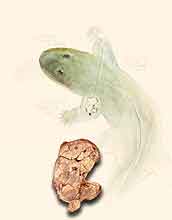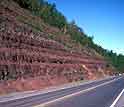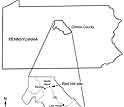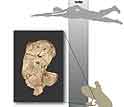News Release 04-035
New Fossil Links Four-legged Land Animals to Ancient Fish

Sketch depicts limb bone, which bridges the evolutionary gap between fishes and amphibians.
April 1, 2004
This material is available primarily for archival purposes. Telephone numbers or other contact information may be out of date; please see current contact information at media contacts.
Arlington, Va.—How land-living animals evolved from fish has long been a scientific puzzle. A key missing piece has been knowledge of how the fins of fish transformed into the arms and legs of our ancestors. In this week's issue of the journal Science, paleontologists Neil Shubin and Michael Coates from the University of Chicago and Ted Daeschler from the Academy of Natural Sciences in Philadelphia, describe a remarkable fossil that bridges the gap between fish and amphibian and provides a glimpse of the structure and function changes from fin to limb.
The fossil, a 365-million-year-old arm bone, or humerus, shares features with primitive fish fins but also has characteristics of a true limb bone. Discovered near a highway roadside in north-central Penn., the bone is the earliest of its kind from any limbed animal.
"It has long been understood that the first four-legged creatures on land arose from the lobed-finned fishes in the Devonian Period," said Rich Lane, director of the National Science Foundation's (NSF) geology and paleontology program. "Through this work, we've learned that fish developed the ability to prop their bodies through modification of their fins, leading to the emergence of tetrapod limbs."
NSF, the independent federal agency that supports fundamental research and education across all fields of science and engineering, funded the research.
The bone's structure reveals an animal that had powerful forelimbs, with extensive areas for the attachment of muscles at the shoulder. "The size and extent of these muscles means that the humerus played a significant role in the support and movement of the animal," reported Shubin. "These muscles would have been important in propping the body up and pushing it off of the ground."
Interestingly, modern-day fish have smaller versions of the muscles. According to Coates, "When this humerus is compared to those of closely-related fish, it becomes clear that the ability to prop the body is more ancient than we previously thought. This means that many of the features we thought evolved to allow for life on land originally evolved in fish living in aquatic ecosystems."
The layered rock along the Clinton County, Penn., roadside were deposited by ancient stream systems that flowed during the Devonian Period, about 365 million years ago. Enclosed in the rocks is fossil evidence of an ecosystem teeming with plant and animal life. "We found a number of interesting fossils at the site," reported Daeschler, who uncovered the fossil in 1993. "But the significance of this specimen went unnoticed for several years because only a small portion of the bone was exposed and most of it lay encased in a brick-sized piece of red sandstone."
Not until three years ago, when Fred Mullison, the fossil preparator at the Academy of Natural Sciences, excavated the bone from the rock, did the importance of the new specimen become evident.
The work was also funded by a grant from the National Geographic Society.
-NSF-
-
Image of location where humerus bone was discovered.
Credit and Larger Version -
Image of location where humerus bone was discovered.
Credit and Larger Version -
Sketch depicts limb bone, which bridges the evolutionary gap between fishes and amphibians.
Credit and Larger Version
Media Contacts
Cheryl Dybas, NSF, (703) 292-7734, email: cdybas@nsf.gov
Program Contacts
Rich Lane, NSF, (703) 292-8550, email: hlane@nsf.gov
The U.S. National Science Foundation propels the nation forward by advancing fundamental research in all fields of science and engineering. NSF supports research and people by providing facilities, instruments and funding to support their ingenuity and sustain the U.S. as a global leader in research and innovation. With a fiscal year 2023 budget of $9.5 billion, NSF funds reach all 50 states through grants to nearly 2,000 colleges, universities and institutions. Each year, NSF receives more than 40,000 competitive proposals and makes about 11,000 new awards. Those awards include support for cooperative research with industry, Arctic and Antarctic research and operations, and U.S. participation in international scientific efforts.
Connect with us online
NSF website: nsf.gov
NSF News: nsf.gov/news
For News Media: nsf.gov/news/newsroom
Statistics: nsf.gov/statistics/
Awards database: nsf.gov/awardsearch/
Follow us on social
Twitter: twitter.com/NSF
Facebook: facebook.com/US.NSF
Instagram: instagram.com/nsfgov





